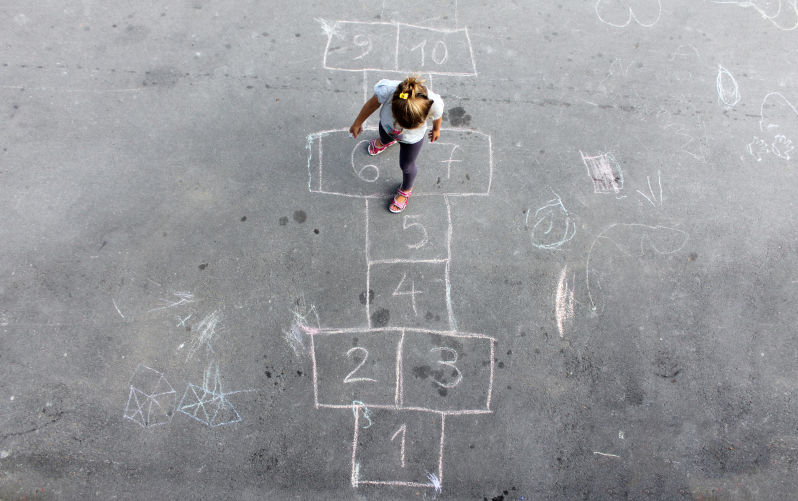Street play: A thing of the past?
February 24, 2024
Wed cross a long rope across the street and I used to have a dozen kids skipping down there. Even Mrs Munro came out seventeen stone and she had no shoes on. Shed come out and skip.
Bernie Johnson was born in 1906, and he contributed this gem when interviewed by the National Library in 1987 for the NSW Bicentennial Oral History Collection. Hed grown up in the inner Sydney suburb of Surry Hills. It wasnt only inner suburbs of the big cities where street play took place in earlier times. My friend Clare Forbes told me about her childhood in the small Queensland country town of Linville in the 1940s, where shed run inside after playing cricket in the street, to listen to The Argonauts on the radio. The only truck to come by all day was Tom Ryan with the wood.
Today, street play is almost a thing of the past. Its little use to bewail its passing, in view of heavy traffic and parental fears. Some of these fears are justified, and some not. Ample evidence suggests that stranger danger comes mostly from close to home, but the rare appalling crime by juvenile offenders can have power beyond its reach.
Talking about street play today is more likely to be talk about outdoor play, and information and opinion are readily available. In 2011 and 2013, books by historians Carla Pascoe and Simon Speight respectively considered the significance of outdoor play and use of outdoor areas. Carla Pascoe wrote about her love of unusual if not derelict play areas in the 1950s, whereas Simon Speight vividly describes numerous uses to which city children appropriated many public spaces in Melbourne from 1871 to 1914. The year 1871 was part of an extraordinary period when Melbourne was bursting with juveniles; 42.2% of the population of the city were aged 14 or under. Interestingly, Speight isnt afraid to address some of the anti-social aspects of their larrikin repertoire, although this isnt his major focus.
There are still many who regret the passing of street play; nostalgic adults, play advocates and not least, architects. Although Im not an architect, I join with many of them in regretting bad design in new housing estates: acres and acres of McMansions with black roofs, no eaves and no backyards.
Lobbying in favour of outdoor play has been around for a while; in 2007 an international symposium was held in Perth entitled Come and Play Outside, convened by Margaret Grose, a lecturer in the School of Architecture at Melbourne University. Its good to know that architects are now commonly consulting or commissioning play experts on matters of school playground design and construction: the hardware can affect the uses which children make of it. Children can often transform the uses of built constructions.
One heart-warming example is the Cat and Mouse installation at a Melbourne primary school. This amazing structure was made with metal piping and wooden seats in a design somewhat reminiscent of a cattle race. Designed by architect Maggie Edmond, it was built by the Department of Public Works in 1983 for a disabled pupil who could only move about with constant supports. The site became enormously popular with the school population as a whole, who created a game called Cat and Mouse, which has become a play tradition, and which gave the name for the installation the Cat and Mouse. After forty years, the game is still played.
Adolescents and young adults are poorly served in public spaces. The positive uses of space can be encouraged by playgrounds for older children, but these are rare, as are challenging installations such as for parkour, a system of leaping and vaulting for the adventurous.
Australians need to be frequently reminded that this country ratified in 1990 the United Nations Convention on the Rights of the Child. Initially adopted in 1989, Article 31 of the Convention recognises the right to play and engage in recreational activities appropriate to the age of the child
Im not sure that the Australian Human Rights Commission is remembering the right to play in their recent activities. The Childrens Commission seems to be engrossed fair enough - with matters of youth justice and incarceration, without recognising that outdoor play and the benign use of public spaces may indeed be related issues.
Ive written about some of the effects of the Covid lockdowns on childrens play in a previous article posted here (The Power of Play, 14/2/24), but what about the effects on physical and mental health when children were unable to meet their friends or play outside?
There are a number of scholarly studies on this subject: the Murdoch Childrens Research Institute at the Royal Childrens Hospital Melbourne reported in February 2022 that child and adolescent physical and mental health difficulties have increased over the 2020-2021 lockdown period, and highlighted the importance of schools as places where the social, emotional and physical health of children and young people can be supported.
Its always worth noting that street play, or outdoor play in general, isnt just a question of physical activity. Group play is socially interactive and intellectually challenging, where decisions have to be made, rules remembered and consideration given to the features of the play space.
Currently, an active advocacy body, Play Australia, is promoting a program 1000 Play Streets, which together with local councils is using quiet streets for outdoor play. The Australian program is based on a successful British program Playing Out, and by 2024, 23 Play Streets are on board in Australia.
You may also be interested to read this recent article from the author:
